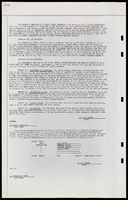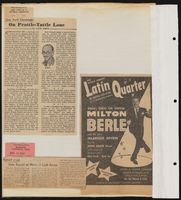Search the Special Collections and Archives Portal
Search Results
Harmon Family Papers
Identifier
Abstract
The Harmon Family Papers consist of the political and personal correspondence of Las Vegas, Nevada pioneer Harley A. Harmon from 1910 to 1934, and his son, Harley E. Harmon, from 1950 to 1966. The collection also includes correspondence, personal papers, and photographs of Harley L. Harmon from approximately 1950 to 1999. Also included are family scrapbooks with wedding announcements, photographs, birthday cards, newspaper clippings, and other ephemera.
Archival Collection
Brian Greenspun oral history interviews
Identifier
Abstract
Oral history interviews with Brian Greenspun conducted by Barbara Tabach on January 10, 2018, January 24, 2018, February 21, 2018, and March 20, 2018 for the Southern Nevada Jewish Heritage Project. In the first interview, Greenspun discusses his parents, Hank and Barbara Greenspun, his family's ancestry, and how his family came to Las Vegas, Nevada. He recalls his childhood in Las Vegas, graduating from Las Vegas High School in 1964, and his decision to attend Georgetown University. In the second interview, Greenspun discusses the Watergate scandal, what he believes will fuel the next decade of Las Vegas growth, and development in the technology industry. He talks about the Greenspun Media Group, challenges in journalism, use of the term “fake news”, and the importance of giving young people a forum to talk about what they value. In the third interview, Greenspun recalls union demonstrations the Sands Hotel and Casino, the impact of American businessman Sheldon Adelson, and the need for balance in journalism. In the final interview, Greenspun talks about his father’s reporting on the Nevada Test Site, underground testing in the 1960s, and the early development of the Strip. Lastly, Greenspun talks about the importance of the University of Nevada, Las Vegas to the city’s future.
Archival Collection
Mark L. Fine Papers
Identifier
Abstract
The collection dates from 1920 to 2019 and is primarily comprised of business and organizational records, press, photographs, scrapbooks, audiovisual materials, awards, and ephemera documenting Mark L. Fine’s career as a real estate developer in Southern Nevada and his work with various government and community organizations. The bulk of the material dates from 1980 to 2005.
Archival Collection
Edythe and Lloyd Katz Papers
Identifier
Abstract
The Edythe and Lloyd Katz papers (1934-2002) provide a glimpse of the social, religious, and educational contributions they made to the community of Las Vegas, Nevada. Materials include photographs, correspondence, newspaper clippings, and awards dating from 1934 to 2002.
Archival Collection
Robert Woodruff Papers
Identifier
Abstract
The Robert Woodruff Papers (1927-2001) are comprised of materials documenting Woodruff’s career and family life in Las Vegas and Henderson, Nevada, as well as his travels around the United States and abroad. Materials include newspaper clippings, photographic prints and transparencies, personal correspondence, and publications such as Las Vegas tourist brochures and pamphlets dating from the 1930s and 1940s. Visual materials include portraits, city scenes, and landscapes throughout Nevada and the United States, as well as some photographs of international travels.
Archival Collection

Transcript of interview with Patrick Gaffey by Stefani Evans and Claytee D. White, August 19, 2016
Date
Archival Collection
Description
One cannot talk about the arts in Southern Nevada without speaking of Patrick Gaffey. The Cincinnati, Ohio, native moved to Las Vegas as a child and has served the local arts community in several roles nearly his entire adult life, retiring soon after this interview as cultural program supervisor for the Clark County Parks & Recreation Department. After earning his Bachelor's and Master's degrees in English at the University of Nevada, Reno, Gaffey married Cynthia Pearson in 1968. In 1981 he began working as a publicist for the Allied Arts Council of Southern Nevada, founding its acclaimed magazine, Arts Alive, and remaining with the organization through its several moves until 1991. In this interview, he speaks to the collaborative nature and long vision of the Southern Nevada arts and architecture community through the founding of Discovery Children's Museum and the Neon Museum and of working with farsighted public entities—the Las Vegas-Clark County Library District, Clark County,
Text

Transcript of interview with Nancy Cummings-Schmidt by Stefani Evans and Claytee D. White, October 18, 2016
Date
Archival Collection
Description
With the explosive growth of the Las Vegas Valley over the past 30 years, it is rare to find someone who has deep battle born roots that go back to the early mining days of Nevada. Nancy Cummings-Schmidt is an example of that rare kind of gem. As a fourth generation Nevadan, her family came to the state in the 1800s form Ireland and England. Looking to capitalize off of the mining boom in Virginia City, they transitioned to ranching. She spent her first years in Reno and when her father went off to fight in the Second World War, her mother moved to Herlong, California and sent her to live with her grandparents. Upon moving to Vegas for fourth grade, her mother remarried and worked for the Las Vegas Sun while Nancy attended the Fifth Street Grammar School and later became a member Las Vegas High School’s first graduating class in 1956. After graduating from high school, Nancy invested in the spirit of wanderlust as it carried her to study theatre at Texas Christian University (which sh
Text
Wilbur and Toni Clark Papers
Identifier
Abstract
The Wilbur and Toni Clark Papers date from 1944 to 1991, with the bulk from 1953 to 1963 and document the lives of Wilbur and Toni Clark in Las Vegas, Nevada and the development of the Desert Inn Hotel and Casino. The collection includes correspondence from Wilbur Clark to those he identified as important individuals including government officials and celebrities. It also includes materials related to Clark’s plan of building luxury apartments near the Desert Inn, and newspaper clippings and scrapbooks about the Clarks and the Desert Inn. The collection contains some audiovisual materials including Wilbur and Toni Clark's home movies, news footage, and film footage of Las Vegas, Nevada and the Desert Inn.
Archival Collection


